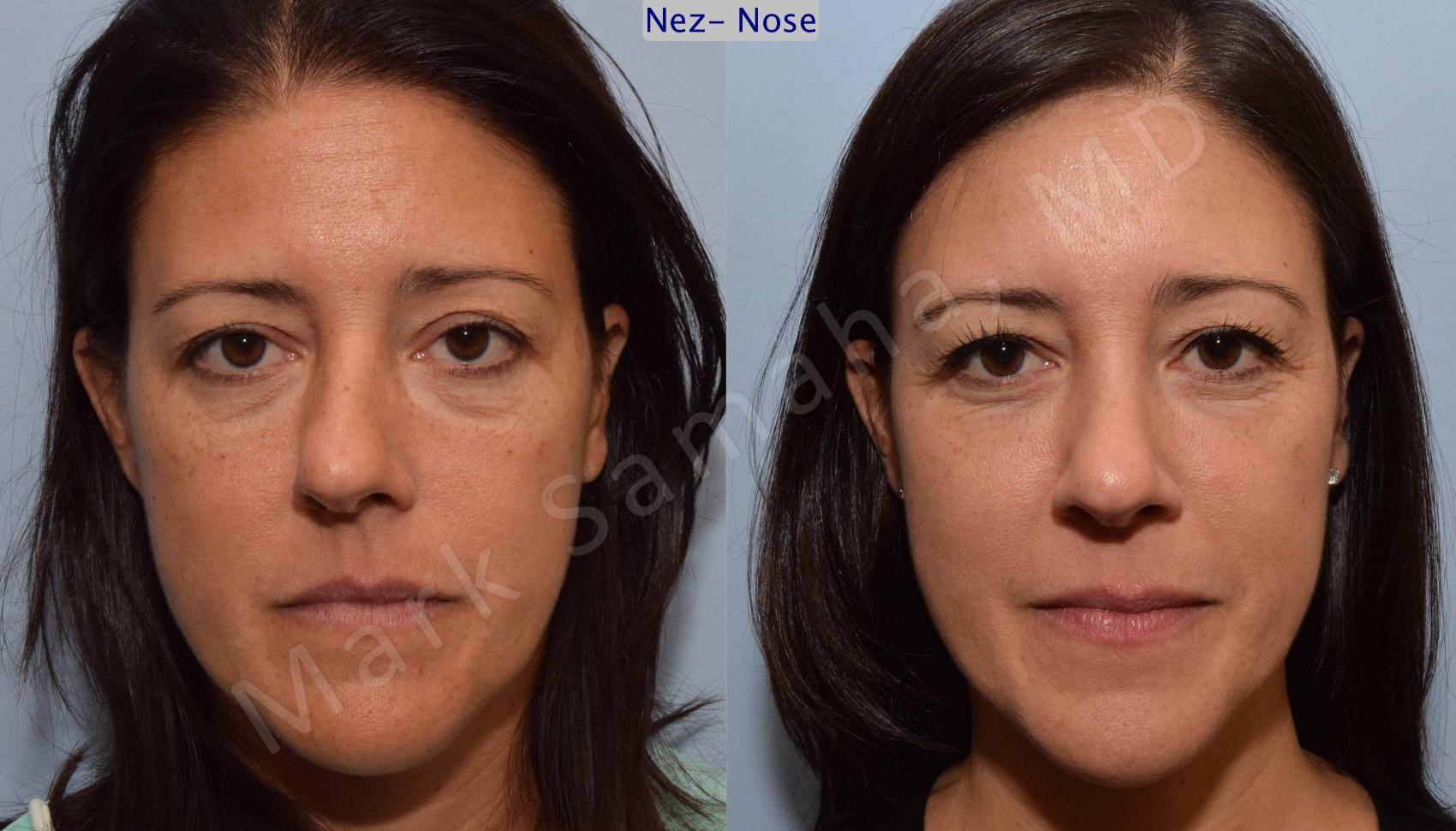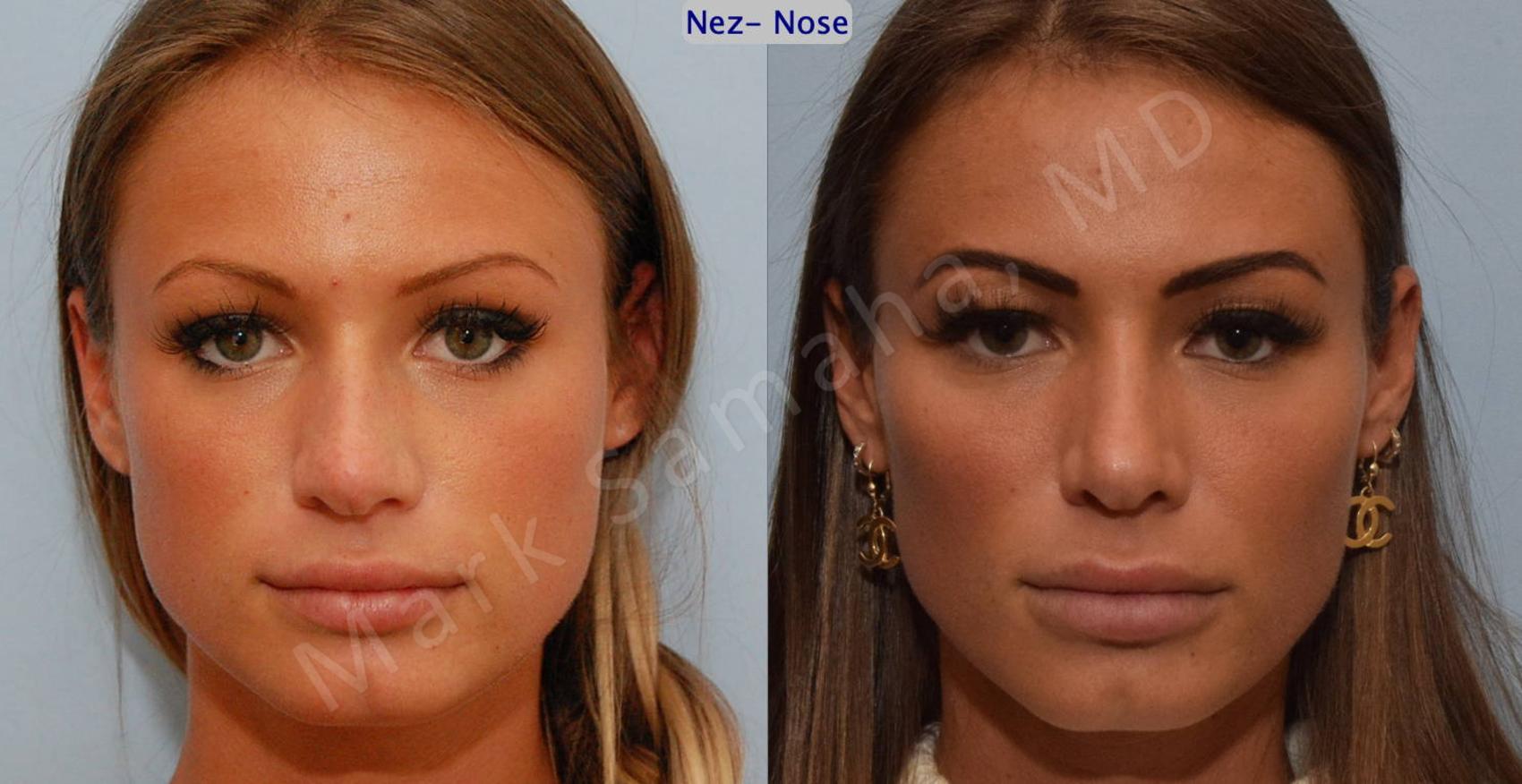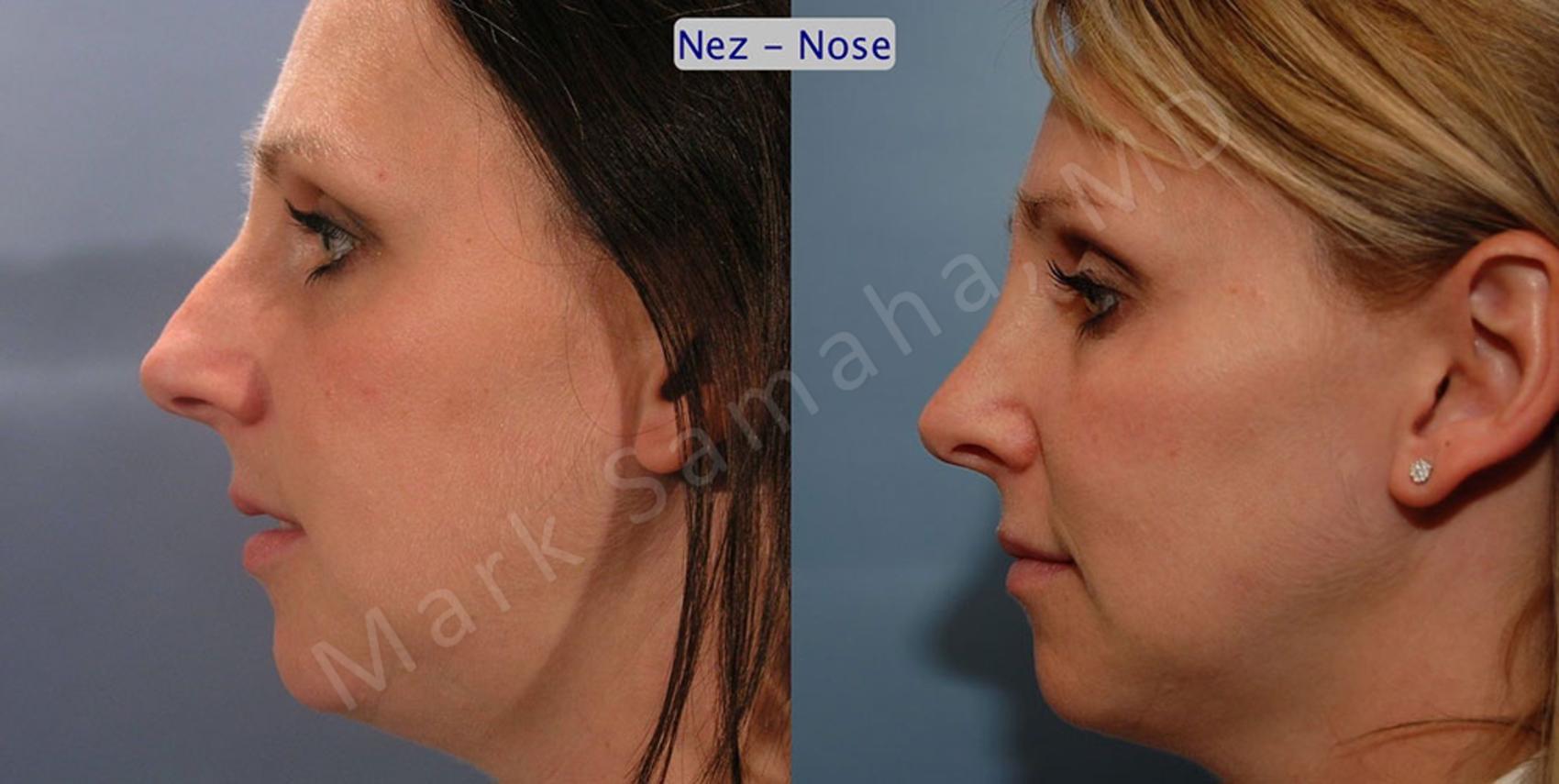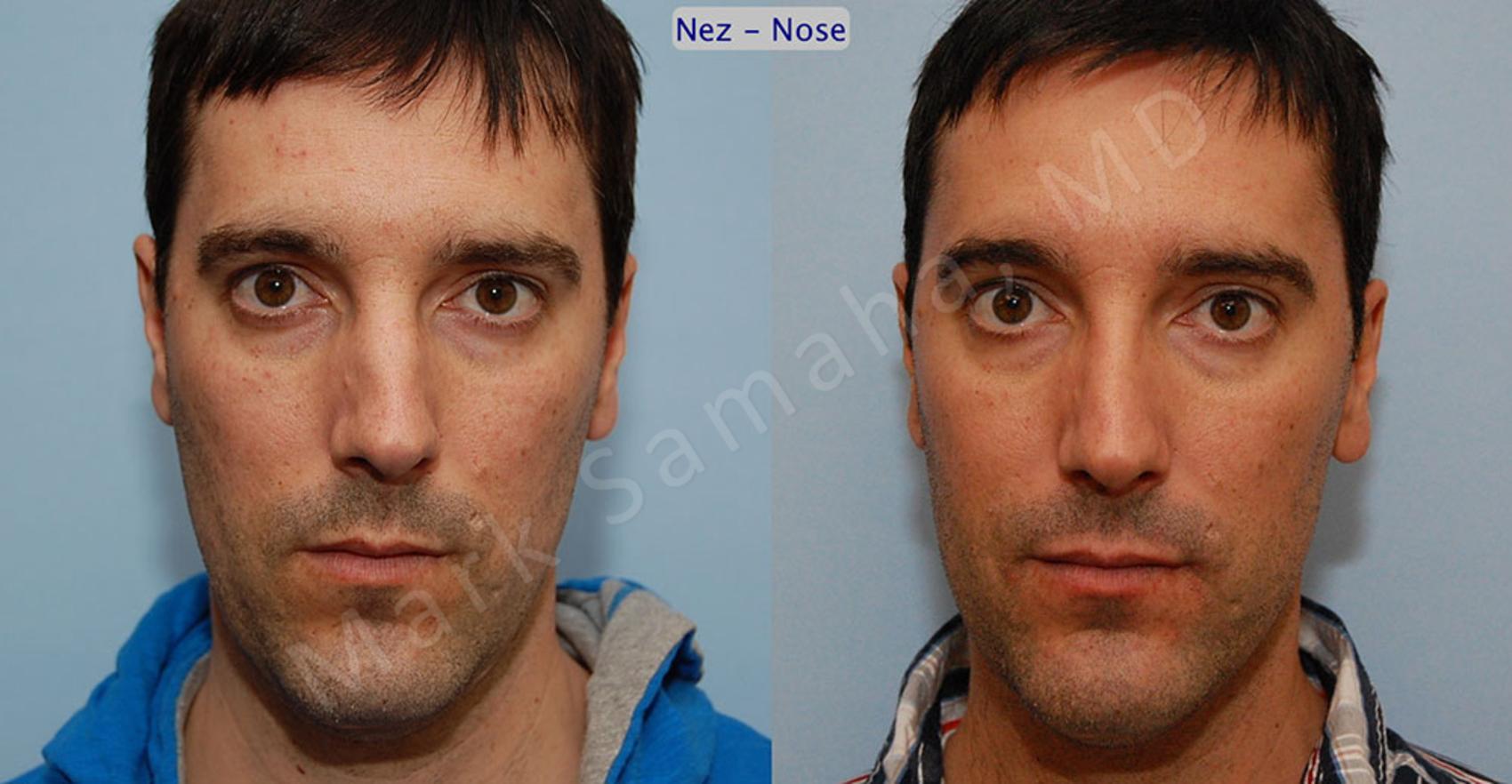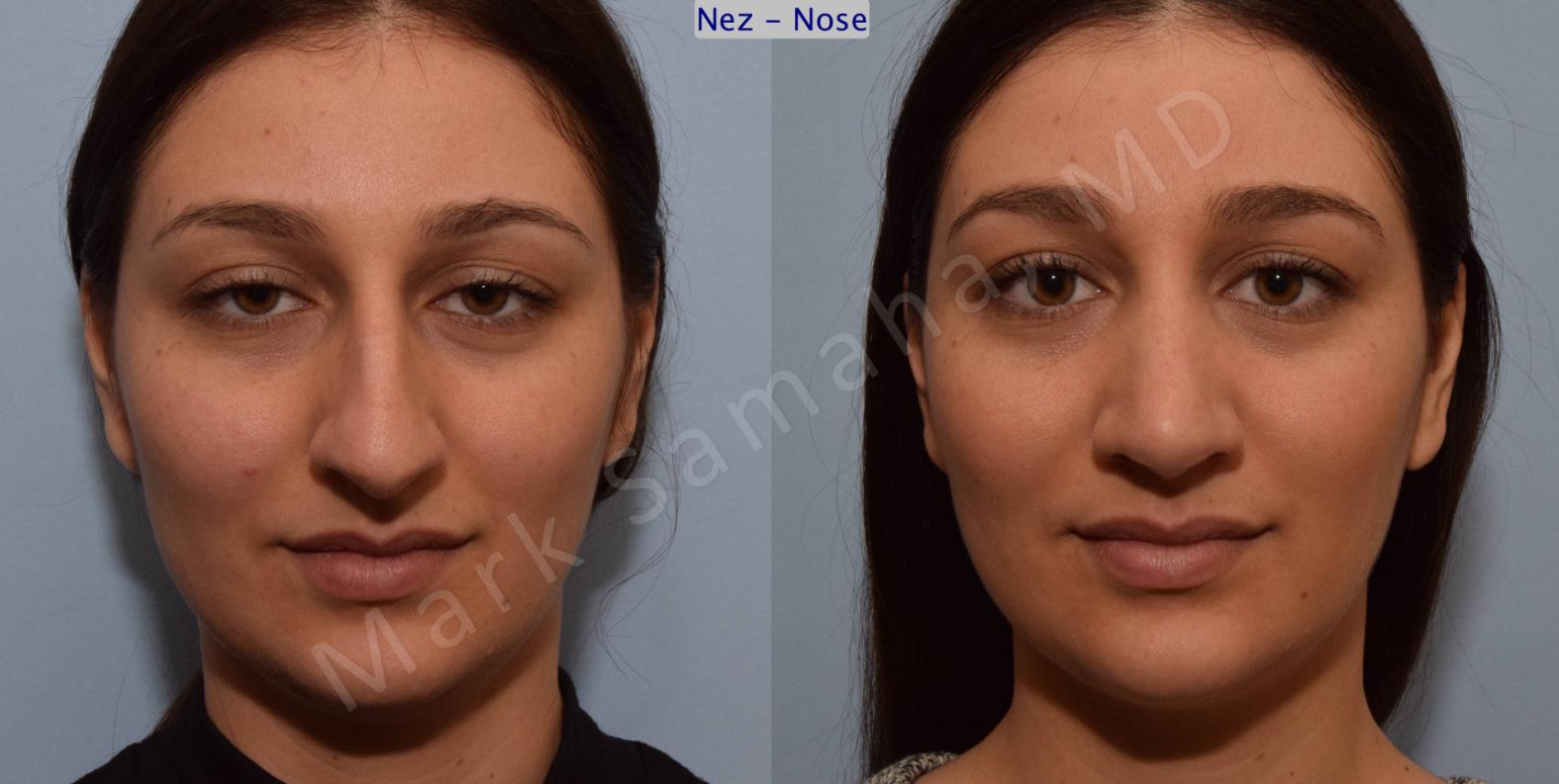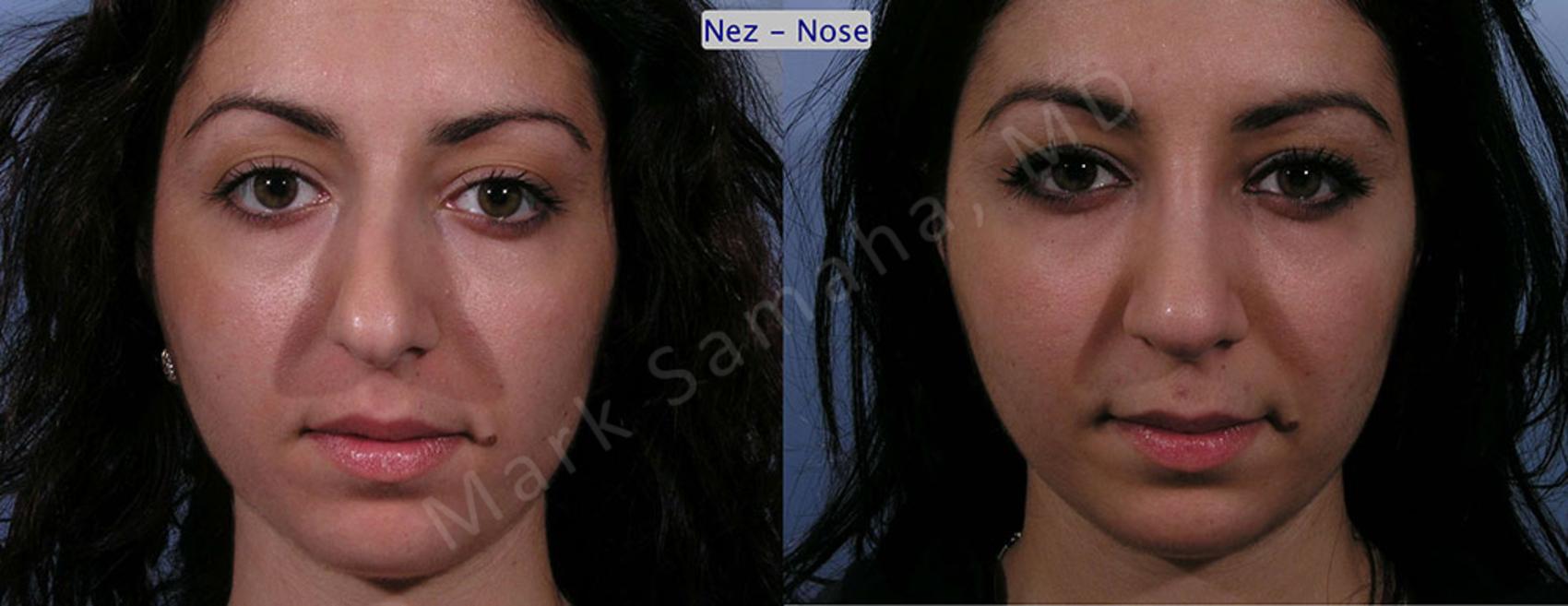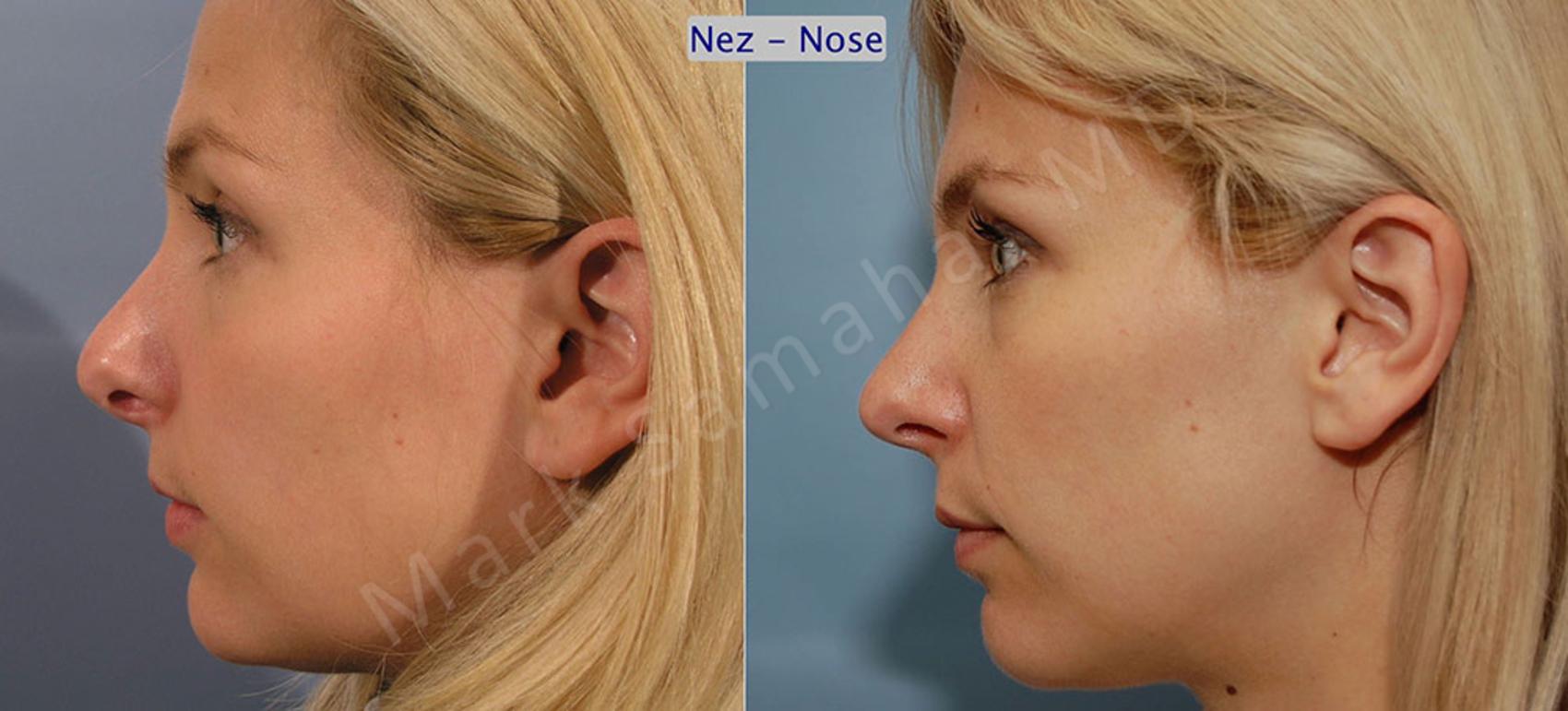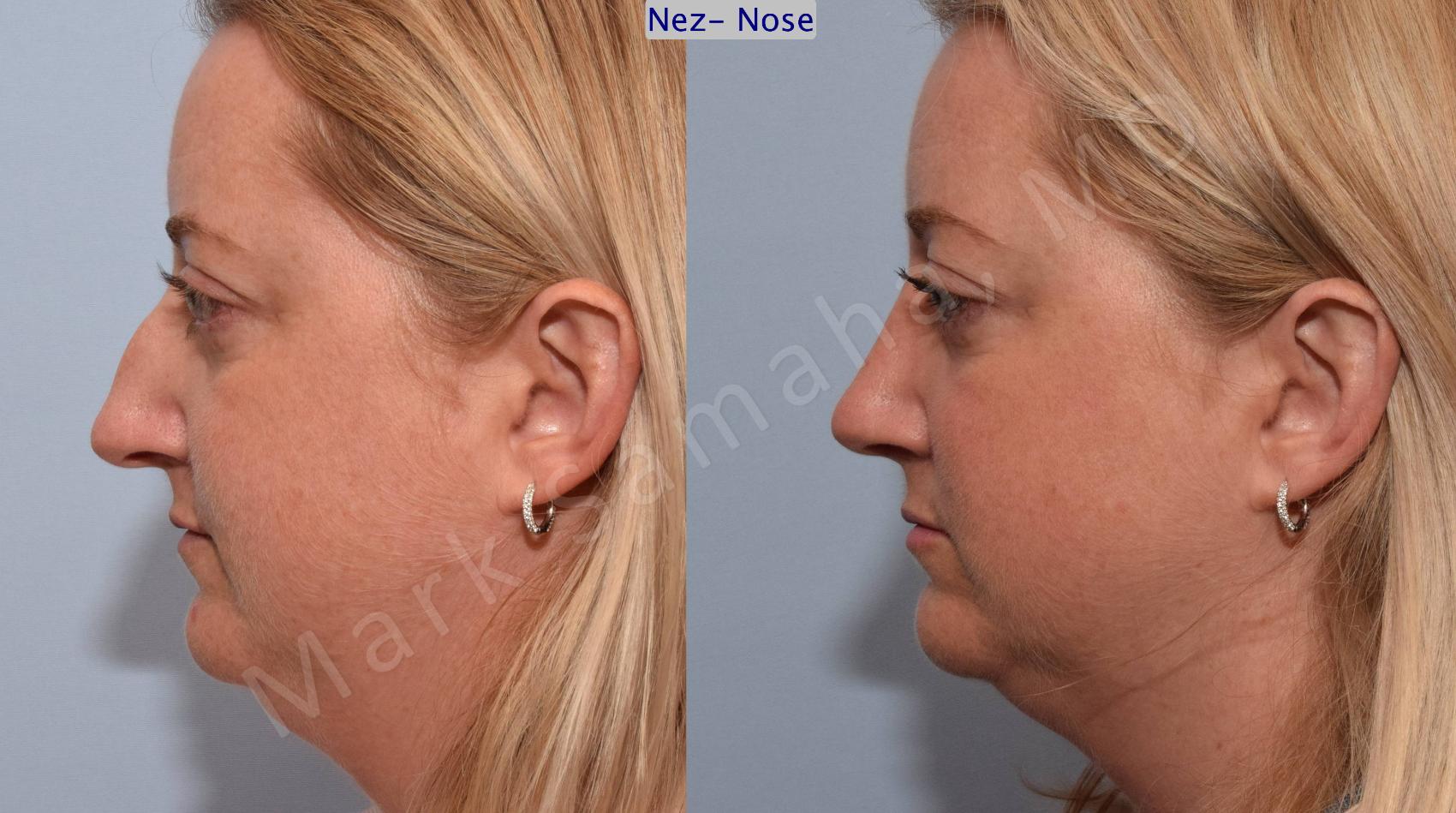Open Rhinoplasty vs. Closed Rhinoplasty
Rhinoplasty consists of modifying the bones and cartilage of the nose to achieve the desired nasal shape and size. “Approach” is a term used by surgeons to describe a path taken to access the area to operate. For rhinoplasty, open approach or closed approach describes different ways surgeons access the bones and cartilages of the nose in order to modify them into an aesthetically pleasing and functional nose.
Rhinoplastie Photos Avant & Après /
Rhinoplasty Before & After Photos
Ces photos sont publiées à titre indicatif afin de fournir de l’information sur la nature de l’intervention. Elles ne constituent aucunement une garantie de résultat.
These photos are published for information only in order to provide information on the nature of the intervention. They do not constitute a guarantee of results.
Open Rhinoplasty Surgery
The steps of an open rhinoplasty approach consist of:
- Incisions are made inside the nostrils as well as on the skin of the vertical partition between the two nostrils.
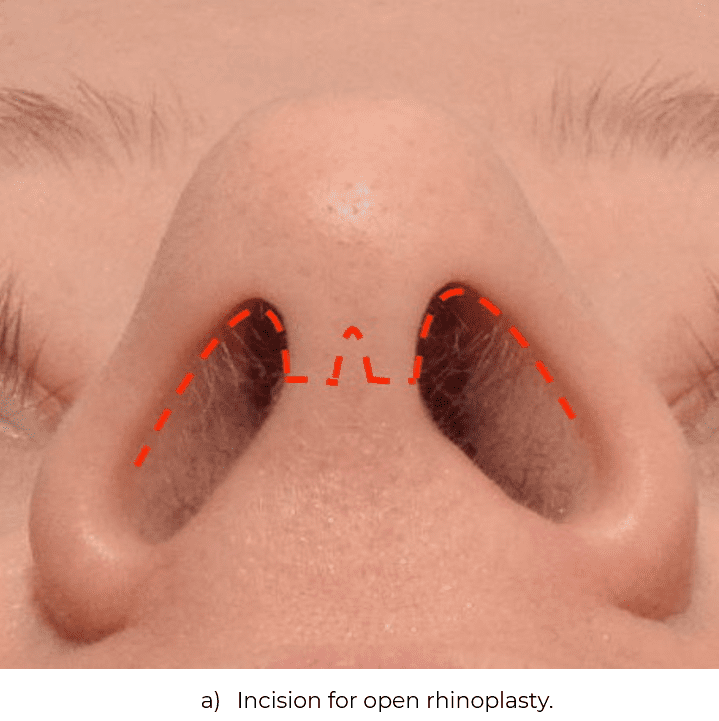
- The skin is then peeled off the tip and the bridge to expose the cartilage and bones of the nose.
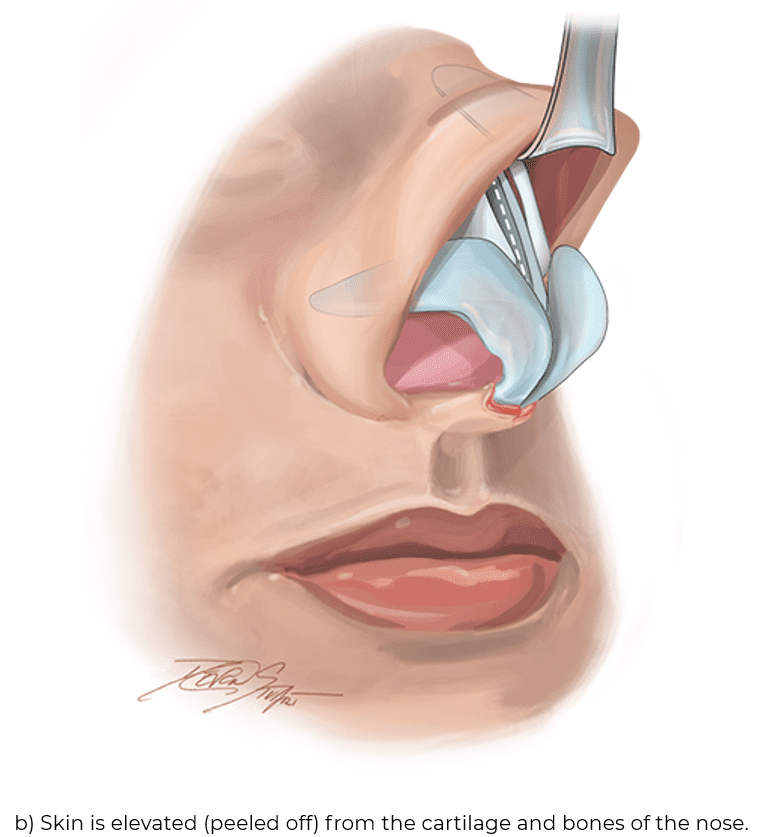
- The bones and cartilage are then altered into a new shape that will refine the nose.
- Because some parts of the nasal anatomy are taken apart and weakened when the skin is peeled off, including the structures that hold the tip in its place, they need to be rebuilt and repaired.
- Cartilage is taken from inside the nose or, in some cases, from the ears to repair and reconstruct the weakened anatomy.
- The skin is put back in place and sutures are placed to close the incisions. These are removed a week after surgery.
- A dressing and a splint are usually placed over the nose to protect it during the recovery period.
Closed Rhinoplasty Surgery
The steps of the closed rhinoplasty approach consist of:
- Incisions are made inside the nostrils only. No incision on the skin is necessary with this approach.
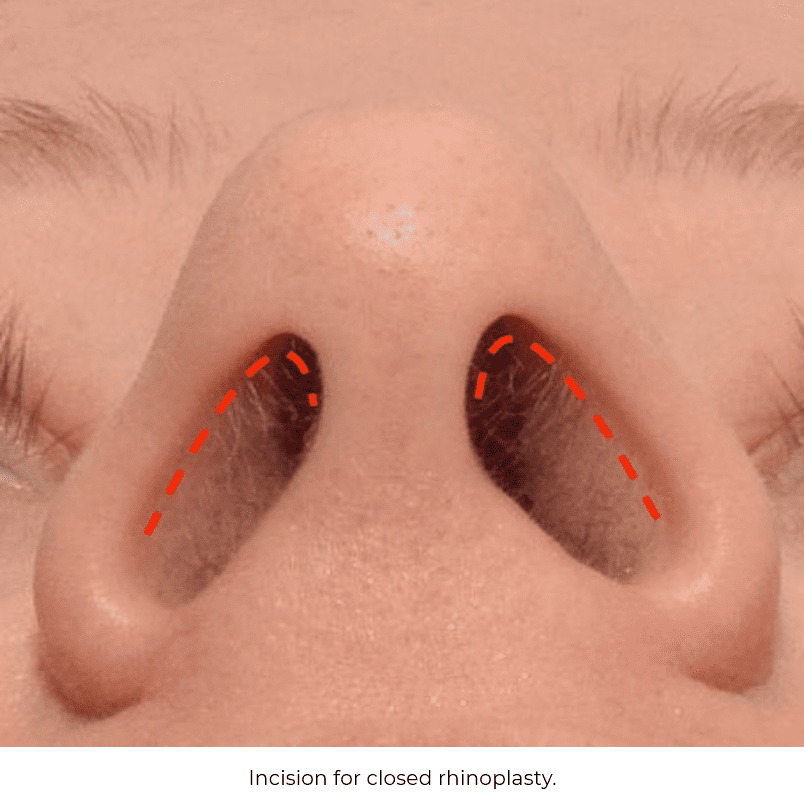
- The bones and cartilage of the nose are accessed by passing instruments under the skin without peeling it off the nose. Imagine the surgeon’s instrument like a “mouse under a rug.”
- The only areas accessed are those that are being modified, rather than lifting the skin off most of the nose, which is done during the open rhinoplasty technique.
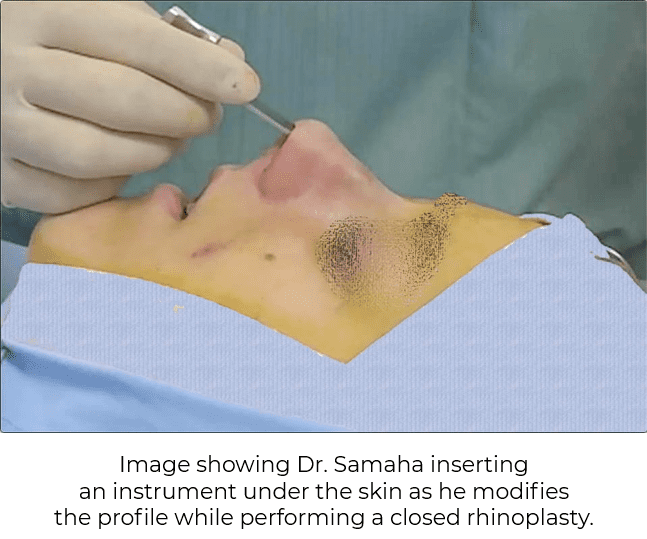
- The modifications and alterations to the bones and cartilage are performed under the skin. The rhinoplasty surgeon is able to see the structures inside the nose by looking through the incisions and making the necessary modifications.
*After each step and each alteration, the surgeon is able to look at the nose from the outside to evaluate the effect of the alterations performed and judge, on the spot, if more cartilage or bone needs to be removed. - Dissolvable sutures are used to close the incisions inside the nose.
- A dressing and a splint are usually placed over the nose to protect the area during recovery.
Meet Dr. Mark Samaha
A double board-certified otolaryngologist whose practice focuses exclusively on facial plastic surgery, Dr. Samaha is highly qualified in facial aesthetics. Learn more about our physician and how he’s carefully refined his skills to sculpt your beautiful face.
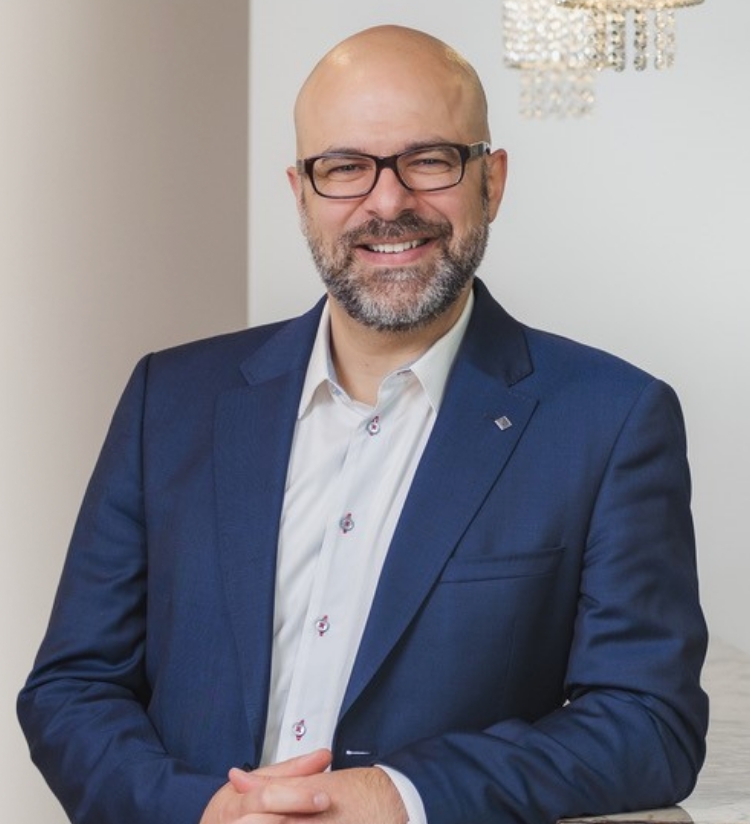
Meet Dr. Mark Samaha
A double board-certified otolaryngologist whose practice focuses exclusively on facial plastic surgery, Dr. Samaha is highly qualified in facial aesthetics. Learn more about our physician and how he’s carefully refined his skills to sculpt your beautiful face.
Advantages of Open Rhinoplasty
While it is true that it is easy to teach and demonstrate the anatomy and maneuvers in an open rhinoplasty, it does not hold true that the surgeon is more able to “see” the anatomy while preforming the procedure.
Disadvantages of Open Rhinoplasty
There are some disadvantages to using the open approach.
- One of the biggest reasons patients opt for a closed rhinoplasty is because the open approach leaves a small external scar. However, if the incision is sutured appropriately and discreetly, the scar should rarely be visible once it’s fully healed. Unfortunately, that is not always the case.
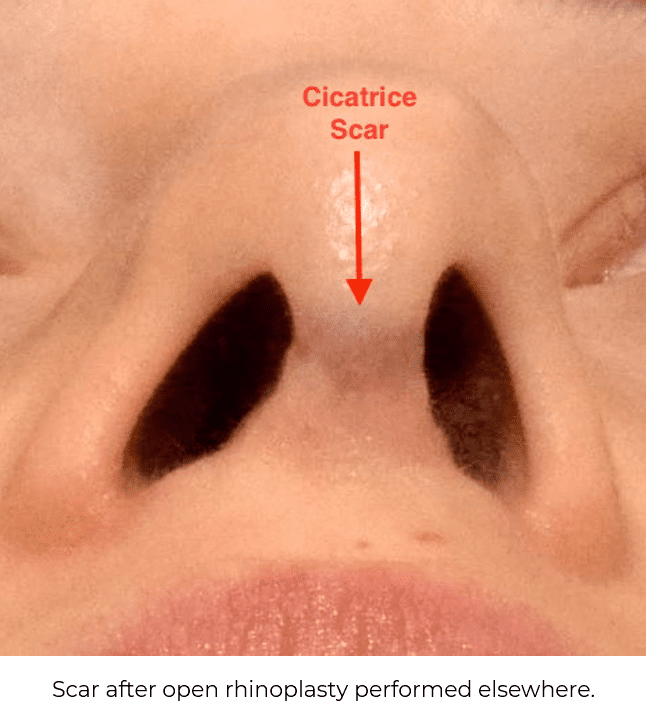
- Some of the structures that support and “prop up” the tip of the nose are weakened because there is a more significant degree of cutting and manipulation of tissues. To make sure the tip does not droop, the surgeon needs rebuild this weakened nasial anatomy by placing cartilage grafts taken from elsewhere in the nose or from the ears.
- The operation takes longer, usually 3 hours or more. This means longer time under anesthesia. In addition to this, longer surgical times often means more swelling and it becomes more difficult for the surgeon to see the fine detail as they modify the nasal structures.
- The surgeon can have a hard time judging the effect of the maneuvers made to the nose during surgery. For example, when the surgeon reduces the size of the cartilage during an open rhinoplasty, it is difficult to immediately look at the nose and determine whether the amount removed was sufficient or if more needs to be removed, due to the nose being “dismantled.”
- The swelling after surgery is often greater and takes longer to fully resolve, resulting in a prolonged recovery period.
Advantages of Closed Rhinoplasty
- There is no visible scar. Although the scar on the skin associated with open rhinoplasty heals well when properly and carefully closed, it remains an additional factor. Like any surgical scar, it can occasionally cause added complications, including healing poorly.
- Closed rhinoplasty is less “invasive” because there is less manipulation and trauma to the tissue. Most importantly, the natural nasal supports are preserved, rather than cut and weakened.
- The surgical time is shorter, meaning that there is often less swelling during and following the procedure.
- The rhinoplasty surgeon is able to immediately see the effect of every maneuver performed, whether it’s removing a hump, or reducing the cartilage, because the skin envelope is intact rather than peeled off.
- The nose does not take as long to “set” after surgery, meaning that patients will be able to see their final results sooner.
Disadvantages of Closed Rhinoplasty
The main disadvantage is the expertise and experience required to perform the closed rhinoplasty procedure. However, when the surgeon has acquired this experience, they are able to perform any maneuver or modification required to achieve the desired aesthetic result.
Dr. Samaha’s Approach
Dr. Samaha has experience using both open and closed approaches. However, he feels that the closed rhinoplasty approach is best.
He has thus far performed over 2,700 closed rhinoplasty surgeries and is highly sought after in Montreal for his expertise in rhinoplasty surgery.
The closed approach, in his experience, provides an easier experience for the patient and leads to an overall better result. The ability to sculpt the nose and see the result immediately on the operating table allows Dr. Samaha to obtain more consistent and predictable esthetic results. In addition, aside from the absence of a scar, his patients usually benefit from a very short recovery period with very little swelling and bruising.
Dr. Samaha’s use of the endonasal approach, combined with a sedation anesthetic, are part of an overall minimally invasive approach that yields excellent results with minimum discomfort and recovery.
If you’d like to learn more about the costs associated with nose refinement surgery, visit the rhinoplasty cost page.
Call our friendly staff now for expert help.
Caring team members are here to take your call from 8 a.m. to 5 p.m.

Call our friendly staff now for expert help.
Caring team members are here to take your call from 8 a.m. to 5 p.m.
Frequently Asked Questions
Is open rhinoplasty or closed rhinoplasty better?
In the hands of an experienced skilled rhinoplasty surgeon, both the open and the closed approach can lead to excellent results. Rather, they are simply different approaches to accomplish the same task, but most surgeons do favor one approach over another due to personal preference and experience.
However, the differences in swelling, bruising, and recovery are important and may factor into a patient’s decision regarding which surgeon is best for them.
How can the surgeon see without opening the nose?
Using a light and some instruments, the surgeon can clearly see the structures of the nose through the incisions. The anatomy of the nose is visible without it being damaged and distorted by too much cutting and manipulation.
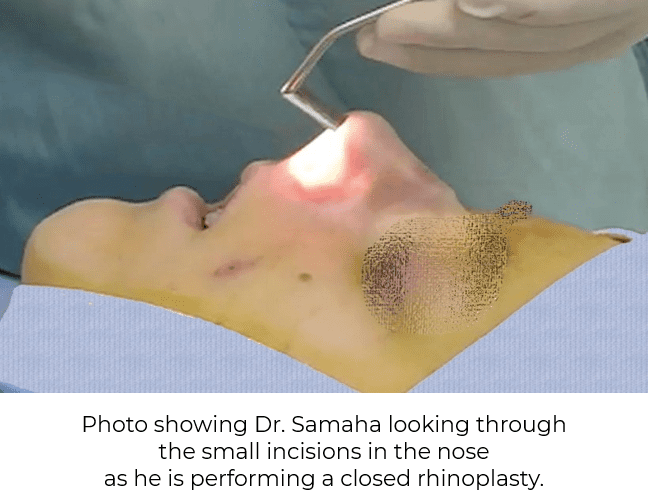
The closed approach means the skin is not lifted and tissues are not widely cut or disrupted. However, it does not mean the surgeon is performing the surgery blindly.
Is closed rhinoplasty surgery painful?
No. The overwhelming majority of Dr. Samaha’s patients report having no pain at all during surgery or throughout the recovery period. In fact, although Dr. Samaha prescribes pain medication to be taken as needed, his patients do not usually need to take them.
What is the rate of success with closed rhinoplasty surgery?
Closed rhinoplasty surgery is associated with high rate of success and patient satisfaction.
It is generally accepted that in North America and Europe, the proportion of rhinoplasty surgeries, open or closed, that need to be touched up or completely redone (revision rhinoplasty) is approximately 15%-20%. In Dr. Samaha’s facial plastic surgery practice, that proportion is 3%-4%. This means that the overwhelming majority of Dr. Samaha’s closed rhinoplasty patients are happy with their result and do not require an additional revision rhinoplasty surgery.
How do I choose the right Montreal rhinoplasty surgeon for me?
The most important factors in choosing a rhinoplasty surgeon are
- Experience: Given the complexity and delicacy of rhinoplasty surgery, experience counts. An experienced surgeon who has performed a large number of rhinoplasty surgeries will be much more likely than a young surgeon with limited experience to deliver a great result. Dr. Samaha has performed over 2,700 cosmetic rhinoplasty surgeries in his over 21 years of practice in the Montreal region.
- The surgeon’s skills and results: The surgeon’s results, as seen in a friend, co-worker, or family member who has had rhinoplasty with him are a good way to evaluate the surgeon’s skills. Before and after photos on the surgeon’s website can also give the patient an idea of the kind of results he can deliver. Dr. Samaha has acquired a reputation for delivering natural rhinoplasty results for his patients.
- Comfort and trust: The patient needs to feel comfortable with the surgeon and have trust, not only in their abilities, but also in their dedication and commitment to providing them with the best possible care. This is based on the feeling the patient gets from meeting and interacting with the surgeon and his team.
We look forward to working with you to create the best rhinoplasty results possible. Request your consultation online or call us at (514) 613-3004. Dr. Samaha attracts patients from Quebec City, Laval, and Gatineau.

